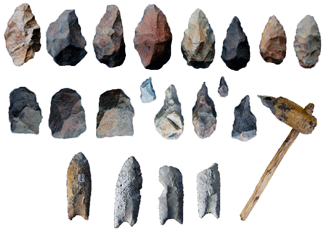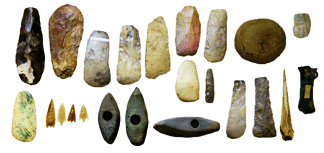As stones are less prone to damage compared to bones, tools and implements made out of stone provide excellent proof about the early humans of Stone Age. Stone tools and implements give evidence of how the early humans made things, how they lived, how they hunted, how they interacted with their surroundings and finally how they evolved. Many archeological sites have been excavated and explored. These sites consist of debris with stone tools. The stone tools also provide evidence about the technologies, skills, and innovations that the early humans had.
The earliest stone tool making developed at least 2.6 million years ago. It began with the most basic stone implements which include hammer stones, stone cores, and sharp stone flakes. By about 1.76 million years ago, early humans began to make hand-axes and other large cutting tools.
Slowly the pace of innovation in stone technology began to accelerate. Mesolithic Age toolkit included pointed and sharp tools, which could be halted on to shafts to make spears. Stone awls could have been used to make perforated hides and scrapers were useful to prepare wood and other materials.
During the Neolithic Age, the pace of innovations reached the peak. People experimented with diverse raw materials like bone, ivory, horns and stone. The level of craftsmanship increased and different groups sought their own distinct cultural identity and adopted their own ways of making things.
The Paleolithic Age includes the most basic stone toolkits made by early humans. The Early Stone Age in Africa is equivalent to what is called the Lower Paleolithic in Europe and Asia.
The oldest stone tools, also known as Oldowan toolkit, consisted of
By the later part of early Stone Age, humans began to strike really large flakes and then shaped them by striking smaller flakes from around the edges. The resulting implements included a new kind of tool called hand-axe.
The pace of innovation in stone technology began to accelerate during the Mesolithic Age. Hand-axes were made with wonderful craftsmanship and ultimately gave way to smaller, more diverse toolkits, with an emphasis on flake tools rather than larger core tools. These toolkits were established early in some parts of Africa, and then in Europe and Asia.

One of the main innovations was ‘core technique,’ in which a core was carefully flaked to obtain a flake of predetermined size and shape in a single blow. This technique raised the skill level in stone technology.
Mesolithic Age toolkits included pointed and sharp tools that could be halted on to shafts to make spears. Smaller pointed stones could be attached to sleeker shafts to make darts, arrows, and other projectile weapons. In Africa, the Mesolithic Age toolkits include blades. Beads and other artifacts indicate the use of colors.
Neolithic Age toolkits are very diverse and reflect stronger cultural diversity compared to earlier times. The pace of innovations reached its peak during this time.

Burins are specialized stone flakes with sharp, chisel-like tips. Humans used them to work on bone, horns, ivory and wood and to carve designs and images on the surfaces of these materials.
- Share with your friends! -
Login to post your comment here...
- or with social Account -